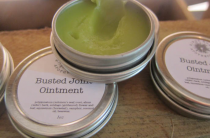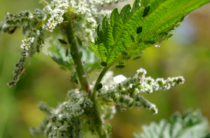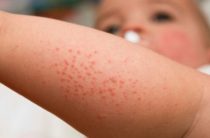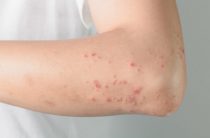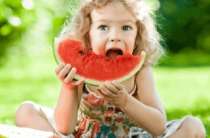Urticaria in children is a skin ailment caused by a predisposition to allergies. It manifests itself as a specific rash on the surface of the skin, without the participation of its deep layers. The disease can be caused by various factors that affect the body both from the outside and from the inside. These symptoms are combined into one group due to the fact that their manifestations are very different both in biological processes and in external characteristics.
In terms of appearance, urticaria in a child resembles a rash that can be seen on the skin after contact with nettle leaves. As you might guess, that's why they gave her such a name.
Why does hives occur?
This disease is in the group of allergic manifestations that have a high rate of development. As a result, there is an accumulation of special biologically active compounds in the body, the most significant of which is played by histamine. Its biological effect leads to the fact that the lumen of the vessels becomes wider. The less dense the tissue, the more easily it passes liquid through itself, which in this case accumulates in large quantities on the surface of the child's skin. Therefore, the hallmark of this ailment is redness and the appearance of bubbles filled with wet contents.
Excluding allergic, urticaria may also have a nervous nature. Under the influence of stress, the child's body begins to secrete a substance - acetylcholine. If it is produced in excess by cells of the peripheral nervous system, then this causes an effect on the expansion of skin capillaries. As a result, urticaria unfolds, which is not associated with the influence of allergens. In general, such symptoms are experienced by an older child, when, as they grow older, the variety of stress factors also increases. Small children, on the other hand, rarely experience such stress disorders due to their lifestyle.
The most common allergens that cause hives in children are:
| medicines | antibiotics and non-steroidal anti-inflammatory drugs (ibuprofen, aspirin, ketanov, etc.) |
| food products | cow's milk, chicken eggs, a variety of nuts, honey, chocolate, brightly colored berries and citrus fruits. |
| clothing and skin contact | woolen fabrics, animal hair, powders, detergents. |
| insect venom | poison of mosquitoes, bees, wasps, bumblebees, hornets, centipedes, etc. |
| temperature factors | high humidity, intensity of ultraviolet exposure, cold air (with open areas of the skin). |
Causes of hives in a child
Despite the fact that certain substances or factors in a child trigger skin-allergic reactions, they still cannot be called the causes of diseases. Each of us knows that an allergy is generated by a specific substance in certain people. Healthy children can be exposed to these factors at least all at once - there will be no urticaria. But if the child has an allergy, then the occurrence of urticaria cannot be avoided, except to prevent the ingress of the allergen. Therefore, it is incorrect to apply allergens in the context of the causes of childhood urticaria.
Why does urticaria appear in a child? It is not easy to answer this question. The baby's immune system is a very delicate thing, the work of which can be adversely affected by a wide variety of substances or dietary habits, as well as lifestyle in general.
The first cause of baby allergies is the nature of the digestive system. A child is not born with a gastrointestinal tract fully adapted to all kinds of food. On the contrary, during the period when you need to add natural food, for feeding, most of the foodstuffs the child's body is not able to properly perceive. This is especially true for those children who did not receive breast milk, but instead ate formula milk.
For the proper functioning of the stomach and intestines, breast milk is of fundamental importance. Together with him, particles of food consumed by his mother penetrate into the child's body in microscopic doses. Thus, if the mother ate properly herself, then the child will not be so sharply surprised by the meeting with natural food.
Proteins that come from the external environment are potential allergens for the baby. And food is one of the main sources of these components. An adult with a developed gastrointestinal system easily absorbs most proteins, processing them into the simplest elements with which the immune system does not interact.
And what is happening at this time in the children's body? In a child's body, things are exactly the opposite. His digestion may not be able to properly absorb the elements of the food. This results in proteins entering the bloodstream unprocessed. Our immunity, and especially in childhood, is very sensitive to whole proteins. These conditions most often lead to the development of symptoms of hives in a child.
The development of urticaria in a child is provoked
- Allergic diseases of parents
As a factor in the development of urticaria, heredity is essential. If parents themselves are allergic, then this greatly increases the possibility that hives will occur in a child. Such children need to reach the age of 5-6 months to pass a special diagnosis, which determines the body's susceptibility to probable allergens.
- Dietary inaccuracies of breastfeeding mothers
During feeding, a woman's diet is selected from special products with the least allergenic potential. Alas, many breastfeeding mothers underestimate the importance of these steps. If highly allergenic foods were consumed during feeding, there is a high risk that their components will be found in breast milk. Thus, along with a safe food product, the baby can get a dose of allergens, which will cause hives.
- Errors during the transition to conventional products
In the life of a child, that moment (about 6 months) is a very important moment. This is due to the use of natural products in food. It is necessary to strictly follow the order and list of products that are added to the feeding of the baby. But not only the wrong foods cause children's urticaria. Even an excessive amount of a non-allergenic product can trigger an allergic reaction.
Symptoms of hives in children
The rash, which is a collection of blisters of various shapes and sizes, is the main clinical picture that makes urticaria in a child extremely recognizable. The places where the rash appears are subject to severe itching, which is most acute in the evening. The color of the rashes is represented by various shades of red. They do not have a clear place of their appearance; they can occur on various parts of the child's body. In places of an allergic reaction, an increase in local temperature occurs, it can also affect body temperature, provided that it is located on a large area.
Symptoms of acute urticaria
In children, the symptoms of acute urticaria appear as if from nowhere. The volume that the rash occupies and the diameter of the wheals varies, but in the acute form they largely occupy the skin space. If large elements are located close to each other, this contributes to their association into large forms. Intensive manifestations on the skin of a child do not last long, for several hours, in the future the rash subsides. Naturally, all this takes place if contact with the allergen is eliminated, otherwise, the urticaria will remain for as long as this contact is present.
Symptoms of chronic urticaria
The occurrence of chronic urticaria in a child occurs with long-term contact with the allergen in smaller quantities. With this form of urticaria, the rashes are much smaller both in size and in the amount of space they occupy. At the same time, itching is as intense as in the acute form, causing significant inconvenience to the baby. But the insidiousness of urticaria lies in the fact that much more time must be spent on getting rid of its symptoms.
Diagnosis of urticaria in a child
In order to diagnose urticaria in a child, a wide variety of activities are involved. Special children's doctors are engaged in these activities, as well as in the appointment of treatment: an allergist and a dermatologist. The activities themselves include a medical examination, a conversation with parents during which direct and indirect factors that determine the course of the disease, as well as special tests, are clarified. To begin with, a general blood test is given. With urticaria, you can often notice an increased accumulation of leukocytes and platelets.
Of great importance is the collection of data on the presence of allergic-burdened heredity among the members of the patient's family. Clarifies the features of the child's diet, as well as the availability of a course of drug treatment. With the help of special tests, it becomes possible to track the presence of antibodies to specific allergens. Urticaria in a child may be due to the activity of parasites and the genus of helminths, therefore, special tests are also given to confirm or refute the fact of their presence in the baby's body.
Another diagnostic method is to apply the suspected allergen to the skin. Then, at the site of its introduction, a reaction of urticaria or its absence is observed. Although this method is undeniably effective, it has a number of contraindications, the most significant of which for a child is the age of up to 3 years.
Treatment of urticaria in children
The main tasks facing the treatment of urticaria in a child are the elimination of the allergen, as well as the medical removal of urticaria symptoms. The measures that are taken to eliminate the provoking factor may be different. This is due primarily to the substance itself, which causes urticaria. If she is excited by food, a dietary correction should be carried out.
In the future, when a specific product is clarified, parents need to carefully monitor the composition of food industry products. Allergenic components can be in a variety of foods, the presence of which can not even be guessed. For example, if you are allergic to vinegar, ketchups, mayonnaises, marinades, mustard are prohibited.
Medical treatment
Antihistamines are basic medicines for the treatment of allergic disorders, which also include urticaria in a child. Their effectiveness lies in the fact that they prevent the effects of histamine on the vessels of the skin. As a result, the symptoms of the disease are removed. Antihistamines are presented: claritin, diazolin, suprastin, diphenhydramine, tavegil, clemastine, azelastine, erius, etc.
Corticosteroid ointments can also be used to relieve skin manifestations. When they are prescribed to a child, the strength of their action and side effects should be taken into account so as not to harm sensitive skin.
The use of food sorbents will neutralize the allergen that has entered the body and prevent its absorption in the gastrointestinal tract.
In addition to allergenic foods, during the rampant urticaria, it is also forbidden to eat foods that initially contain histamine. As we remember, it is histamine that is responsible for the appearance of urticaria. These foods include chicken eggs, processed and hard cheeses, tuna, salmon, sardines, squid, shrimp (the most histamine-rich seafood), spinach, nuts, sausage products, canned, dried and pickled foods.
These foods, even though they are not allergens for a child, can play a significant role in exacerbating the symptoms of an already present disorder. For this reason, diet plays an important role in eliminating the symptoms of hives.

